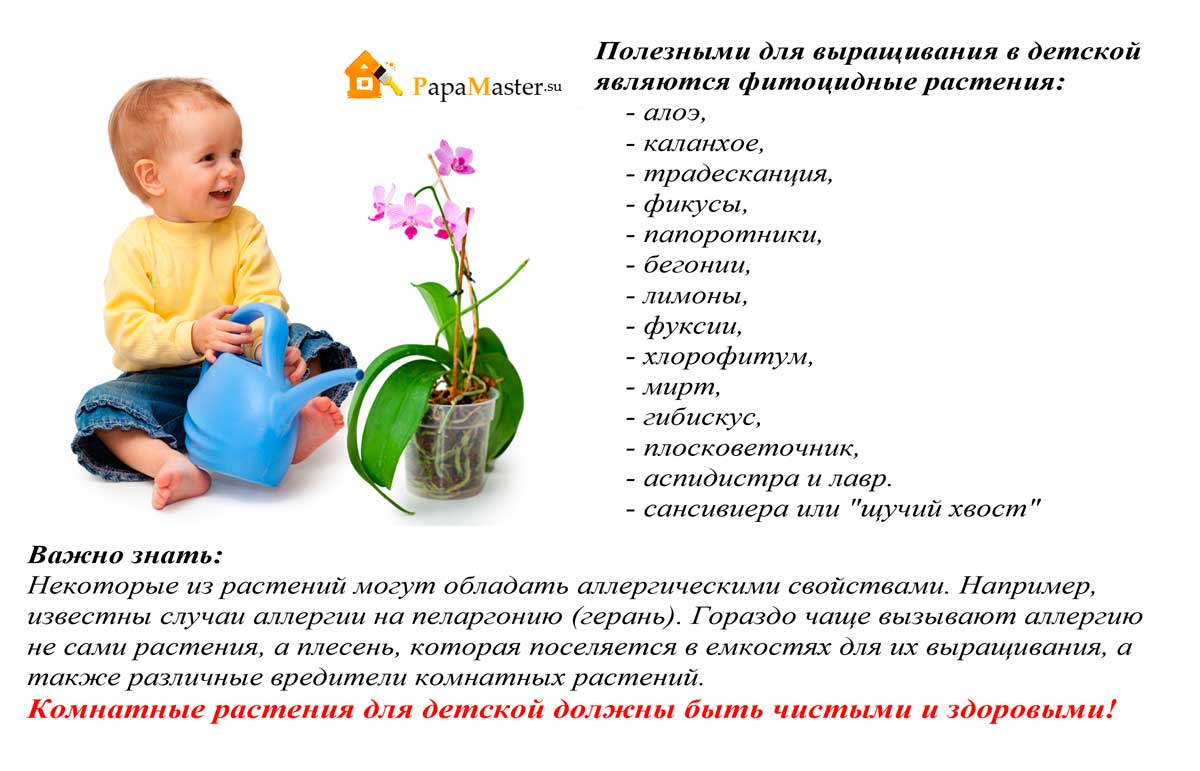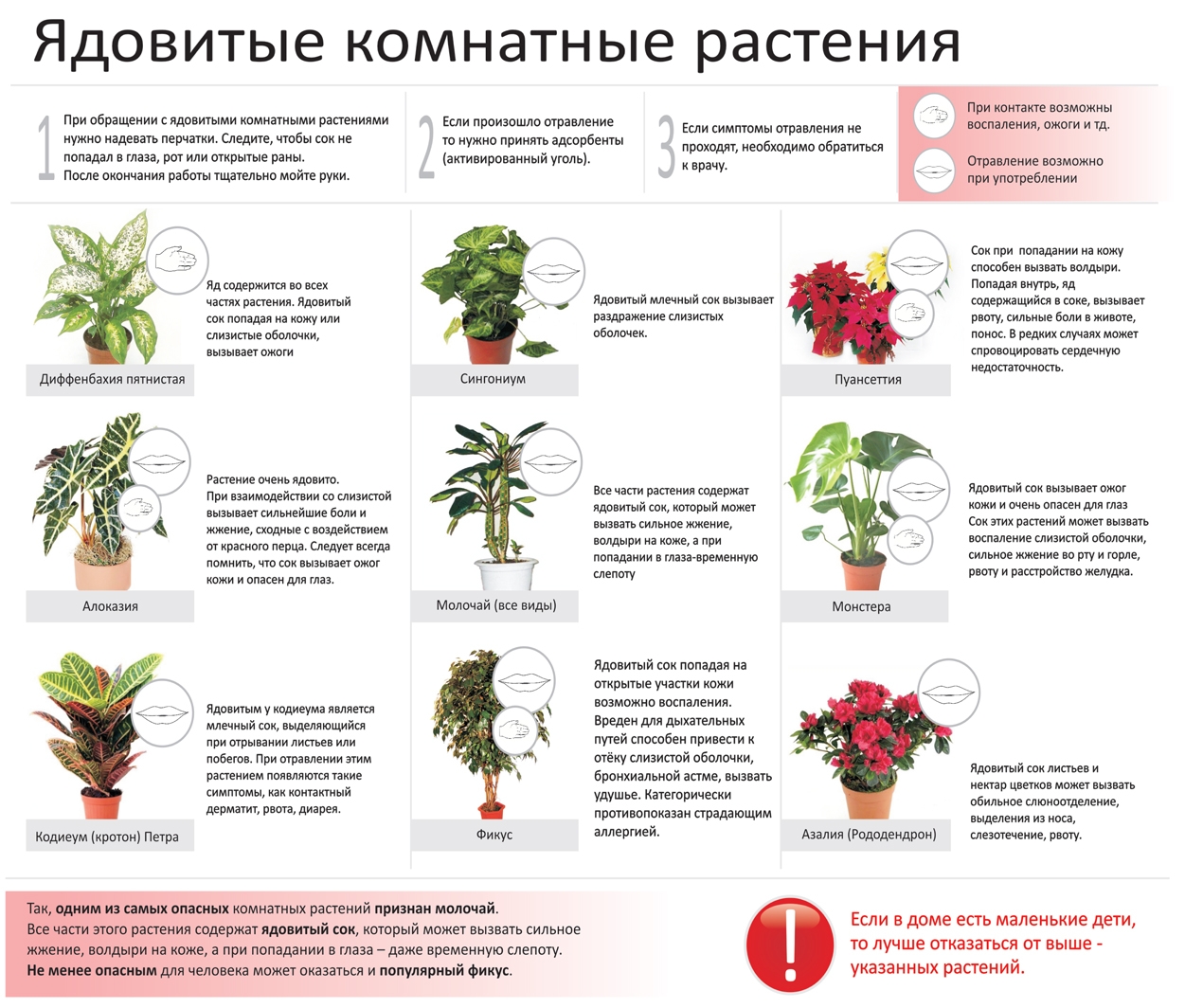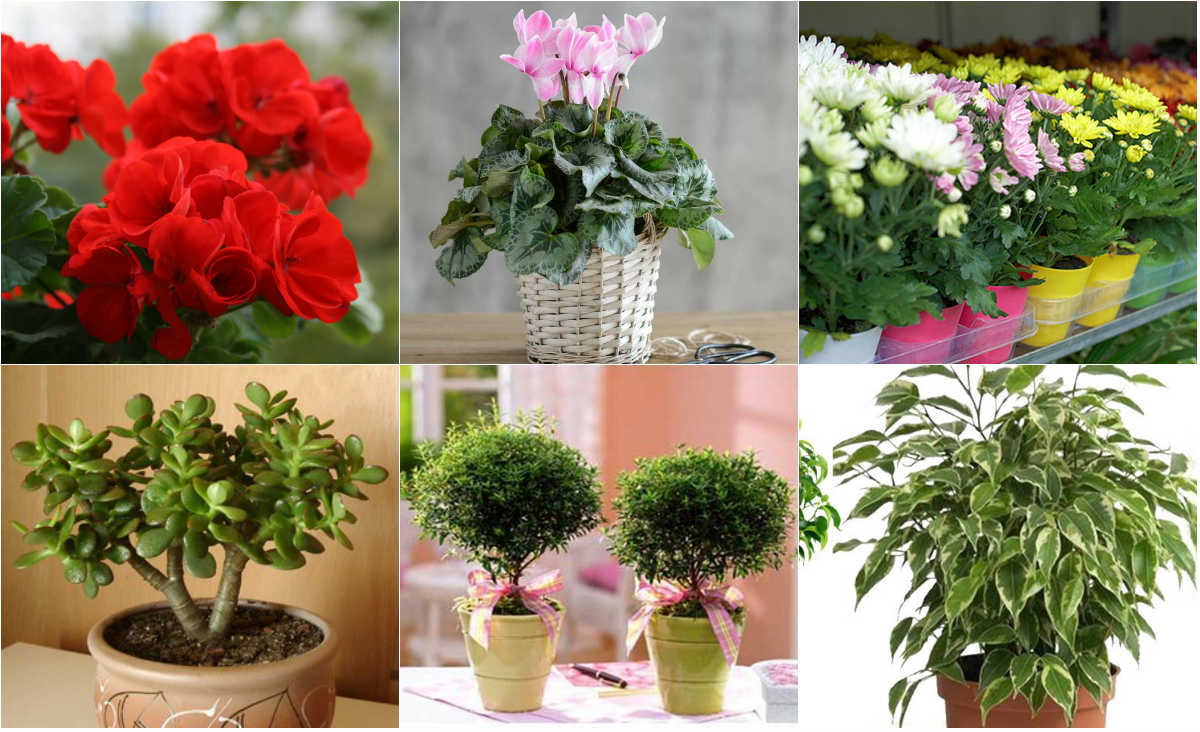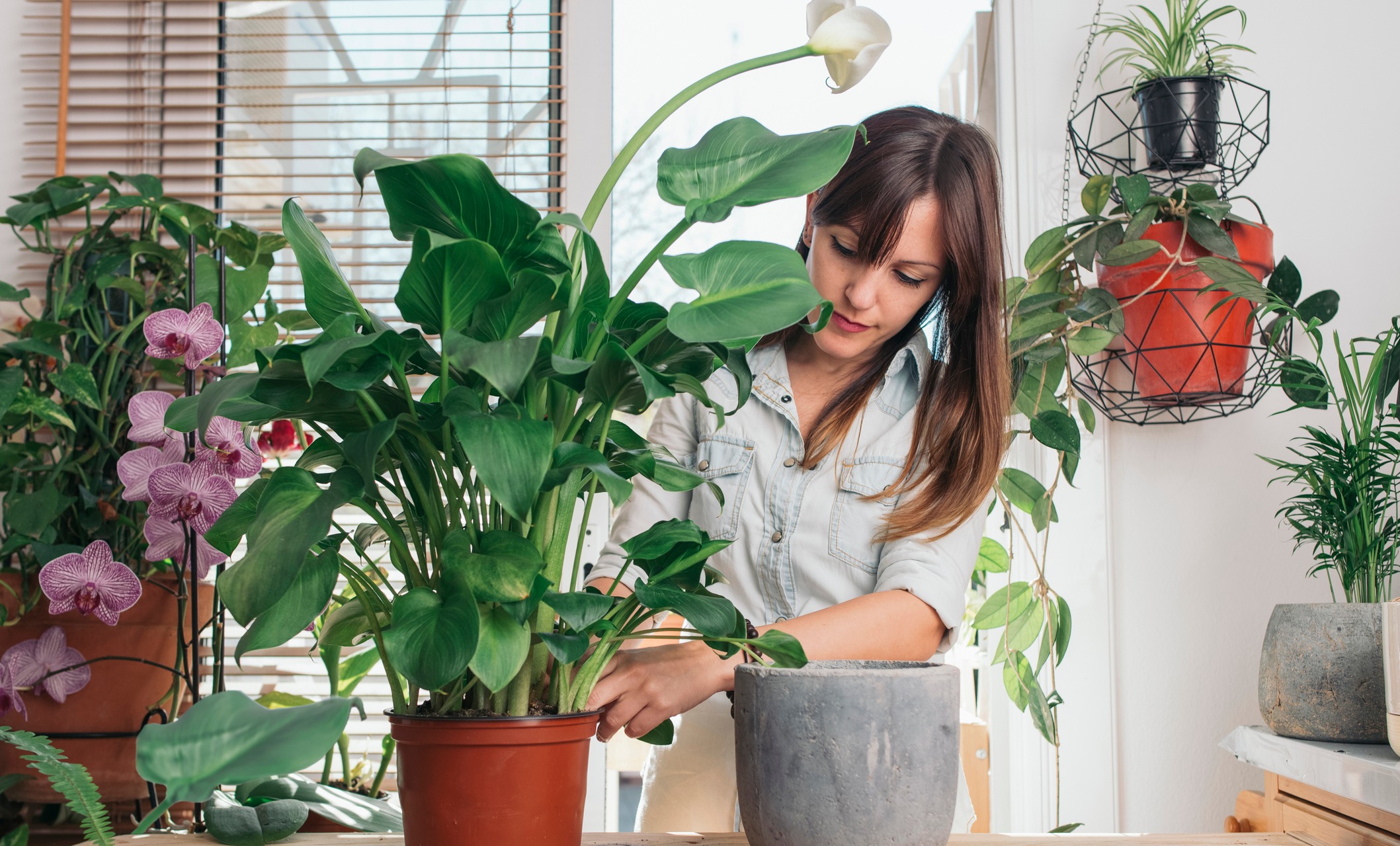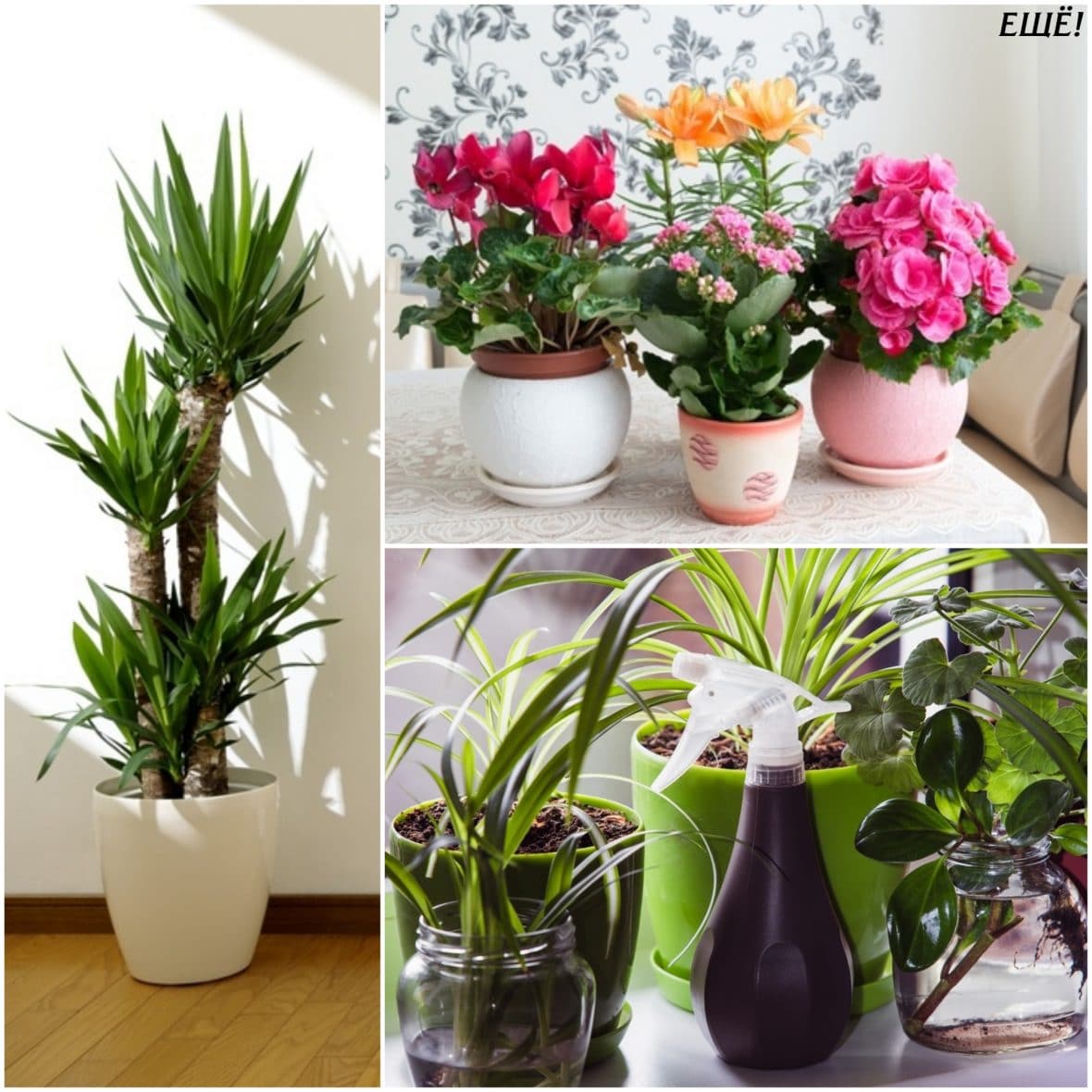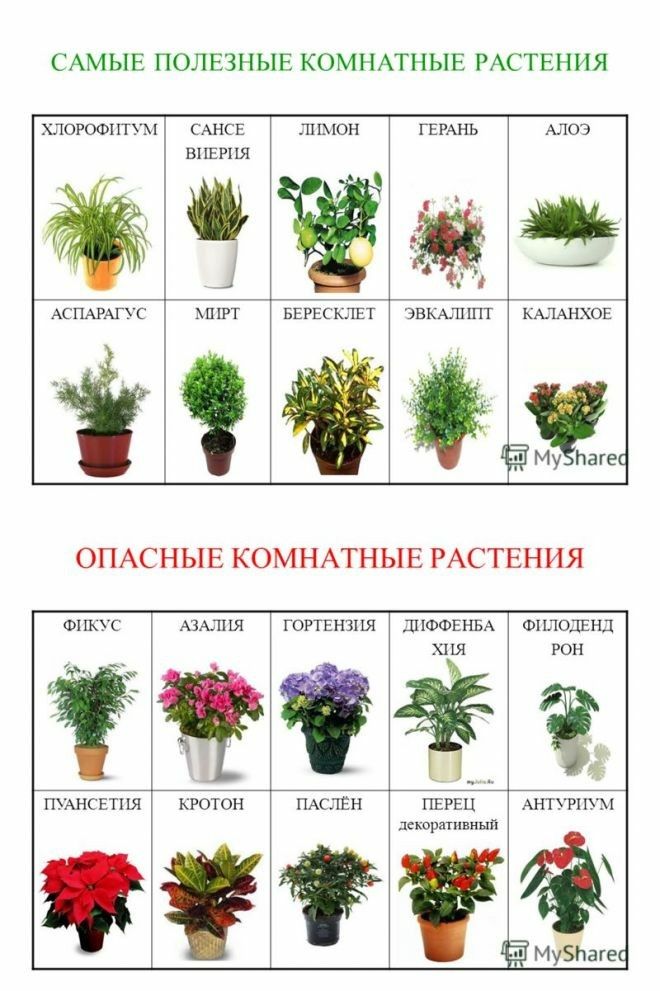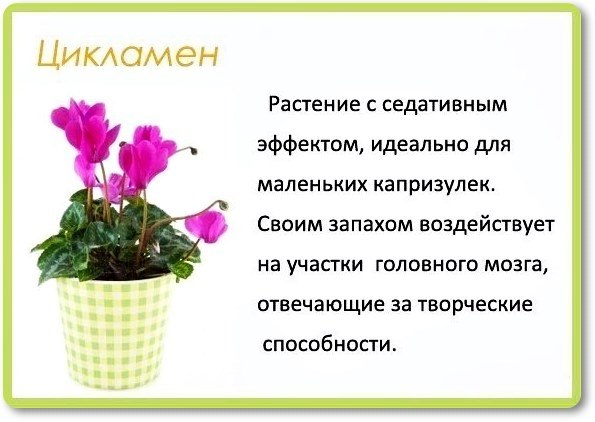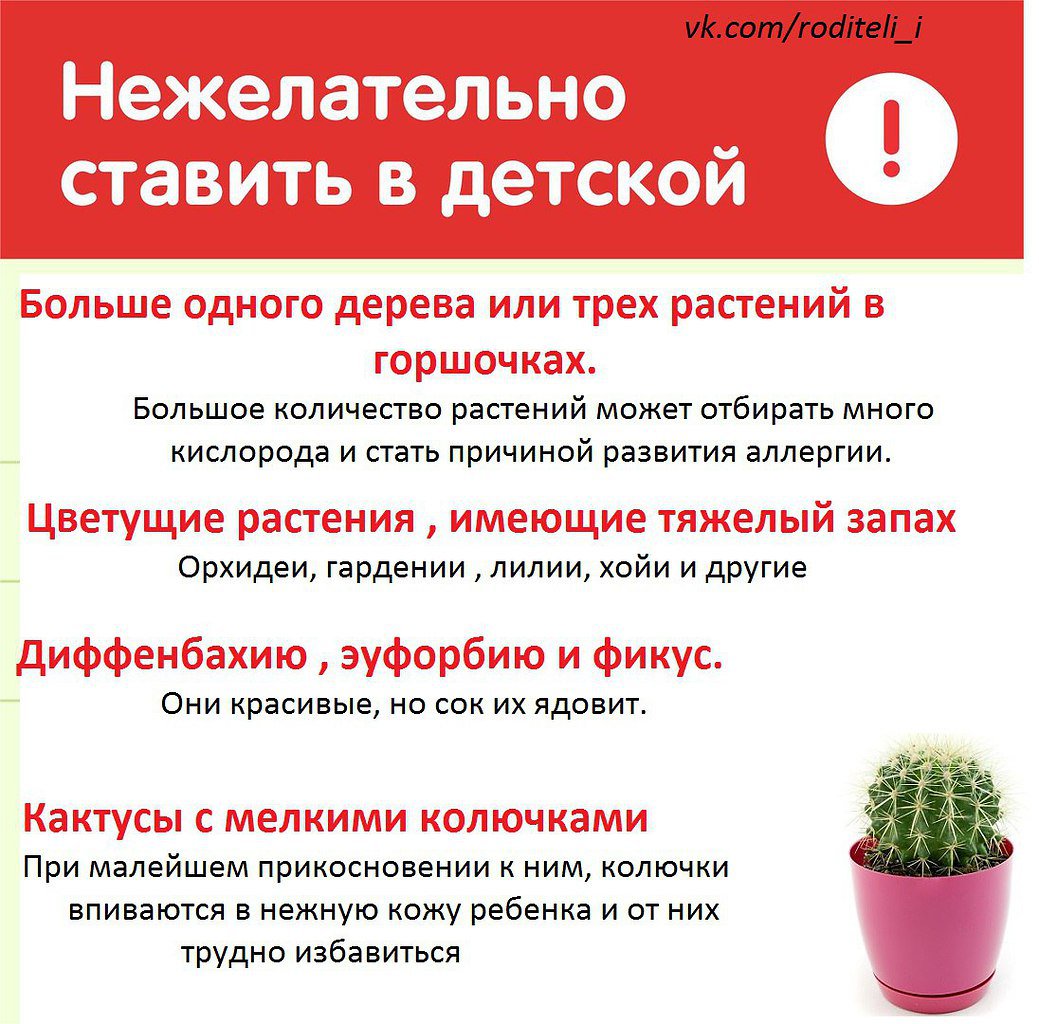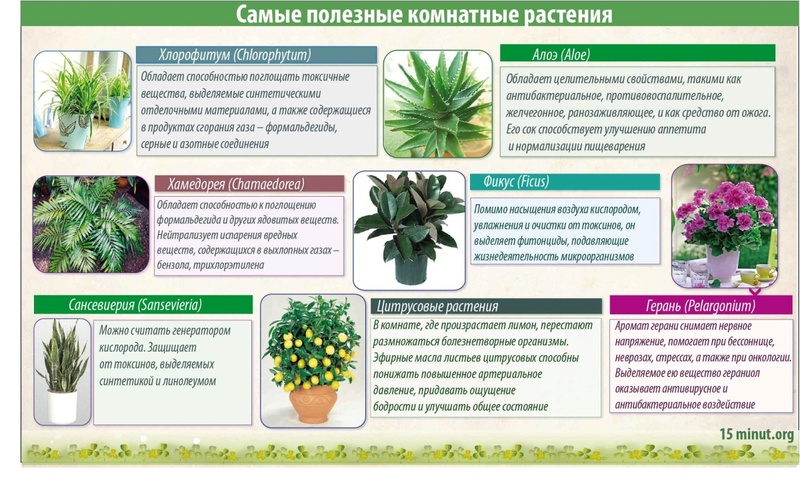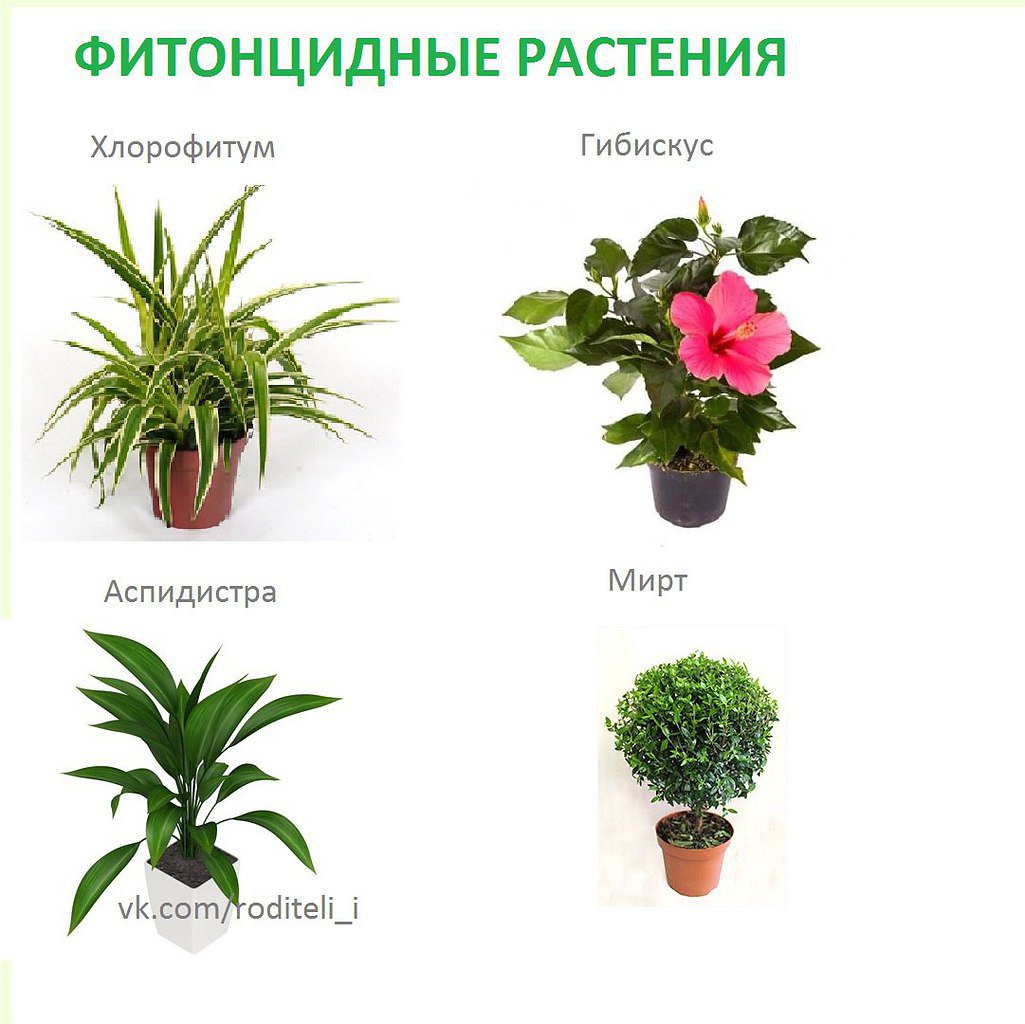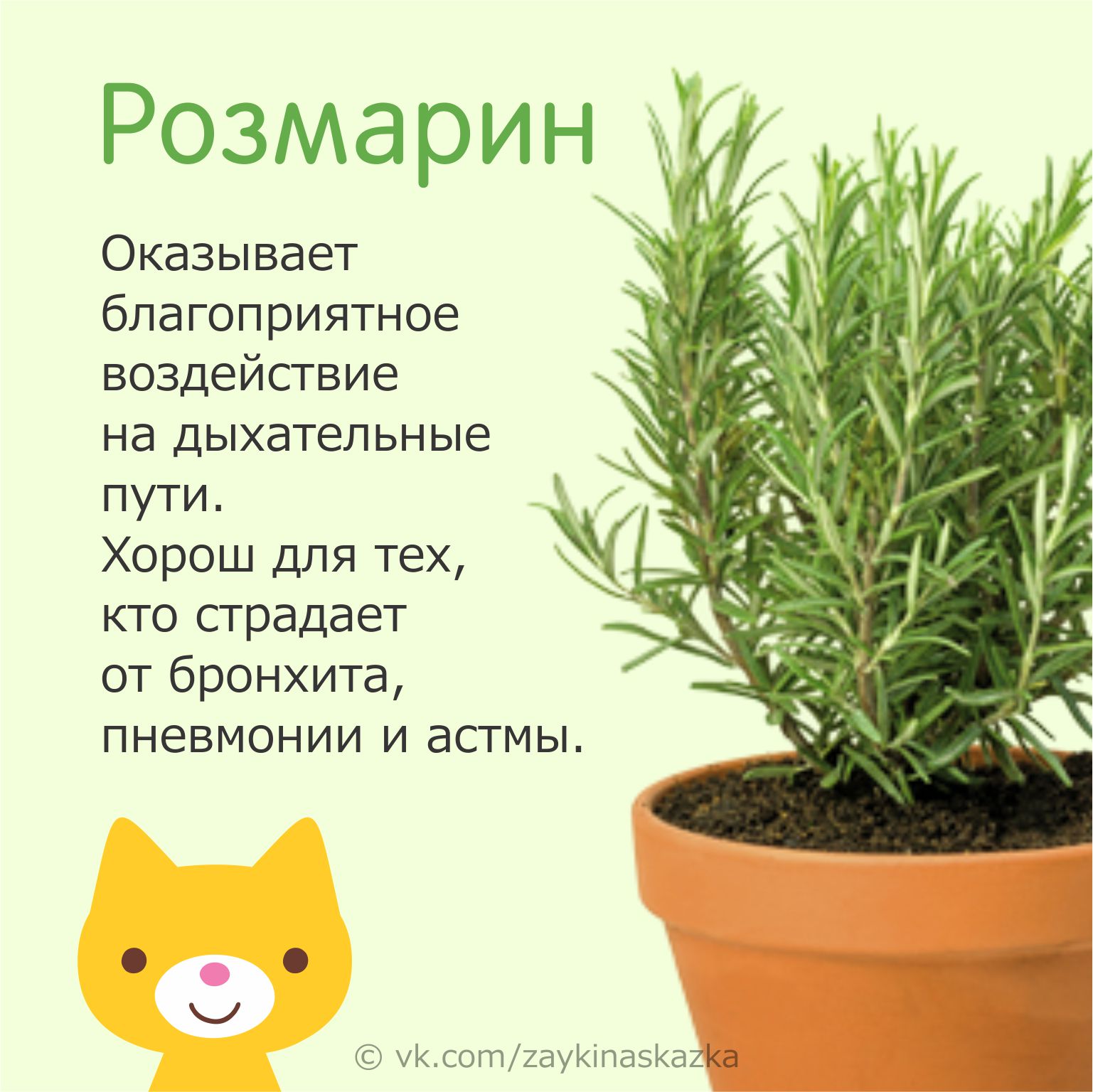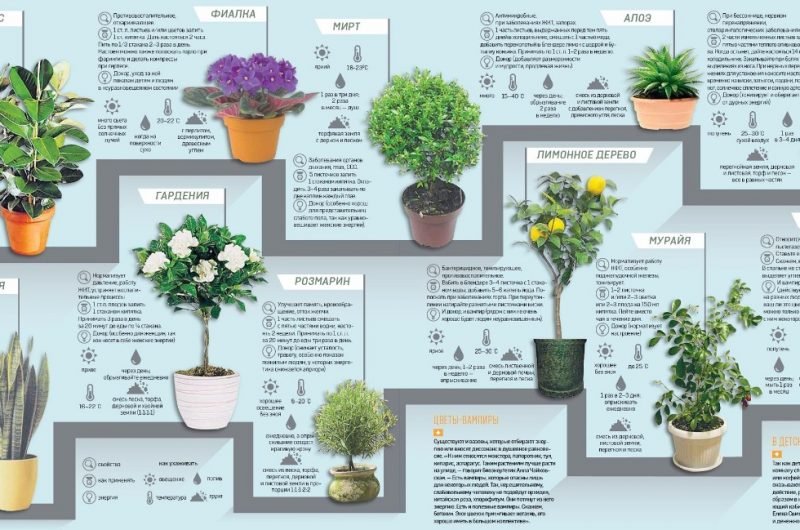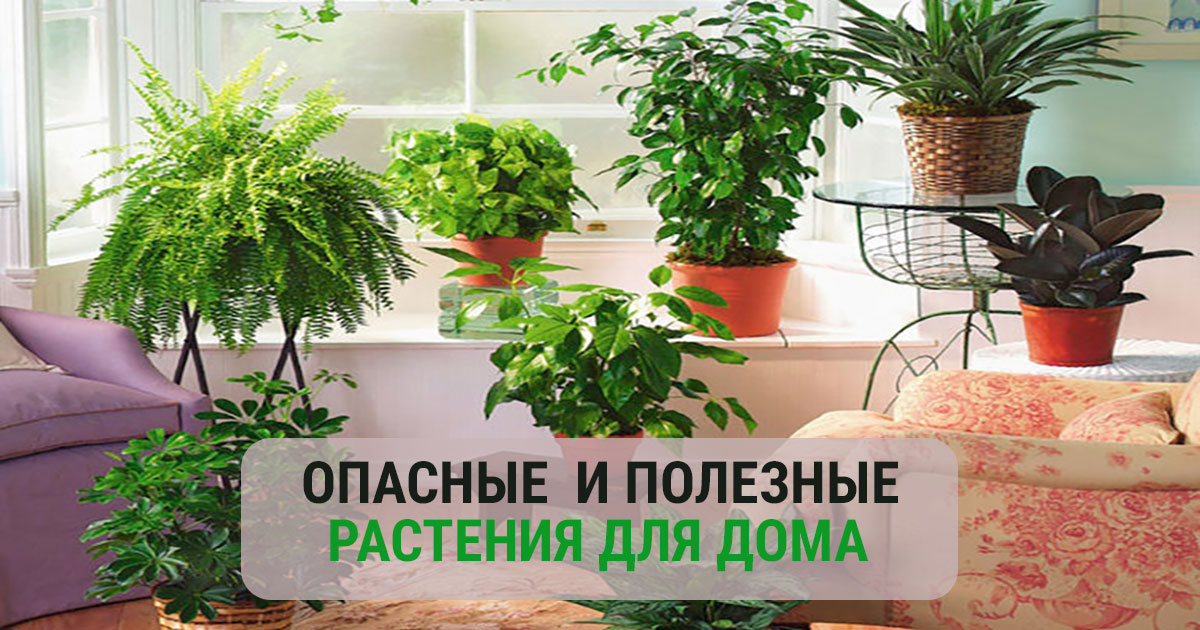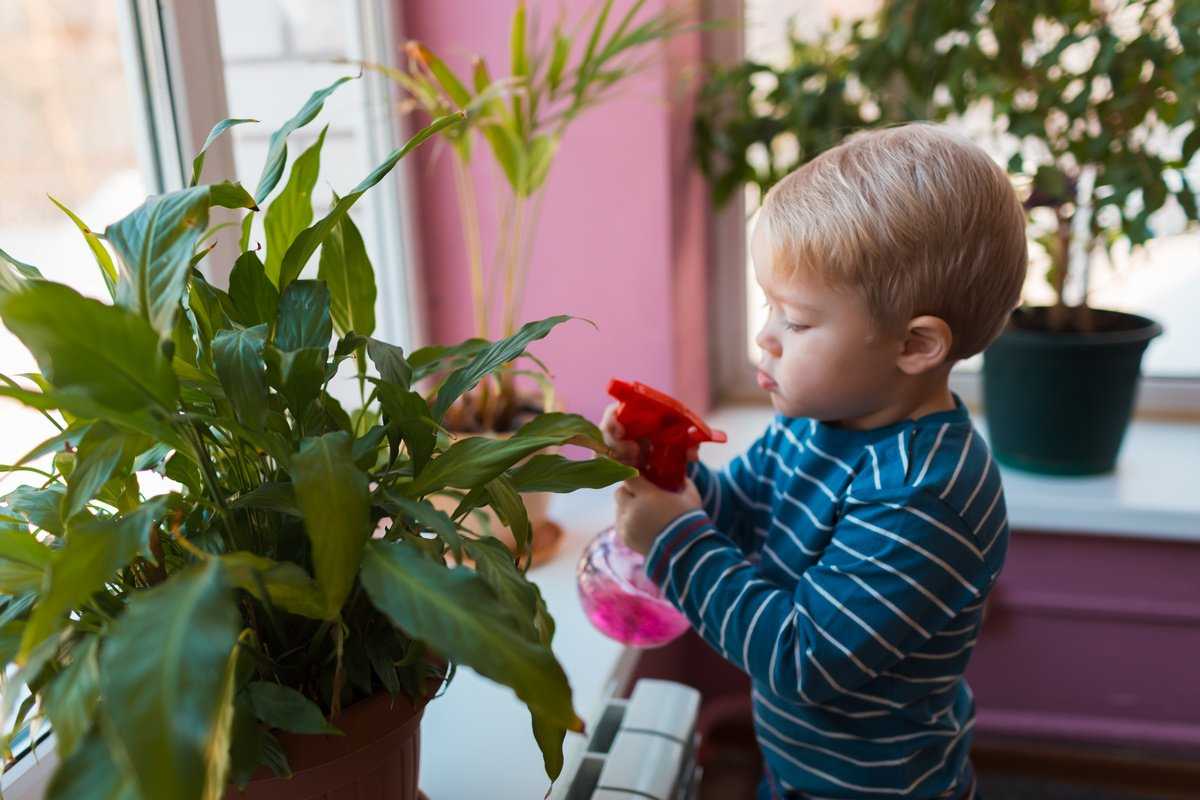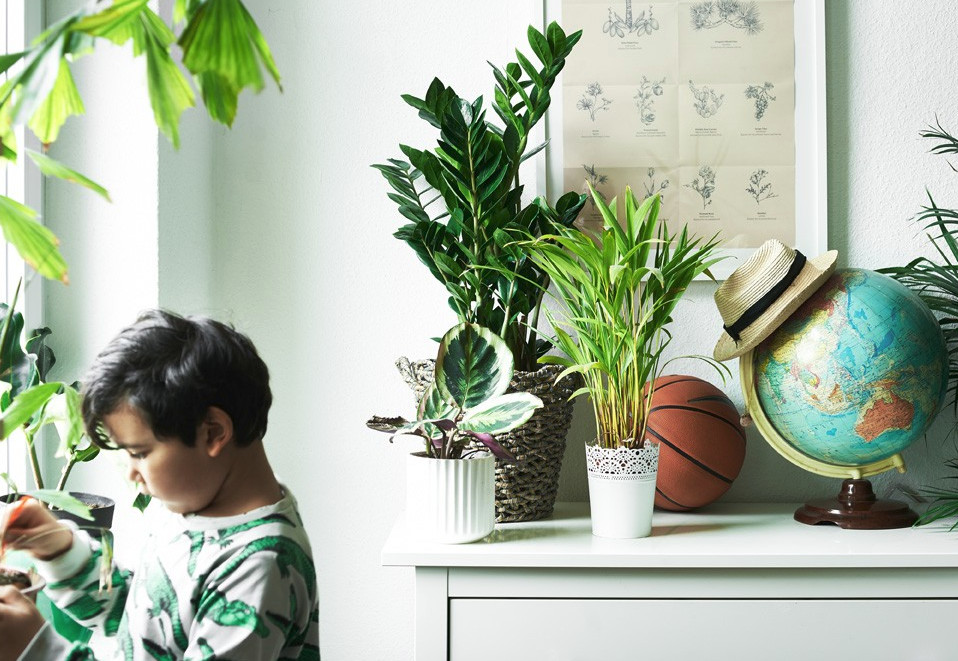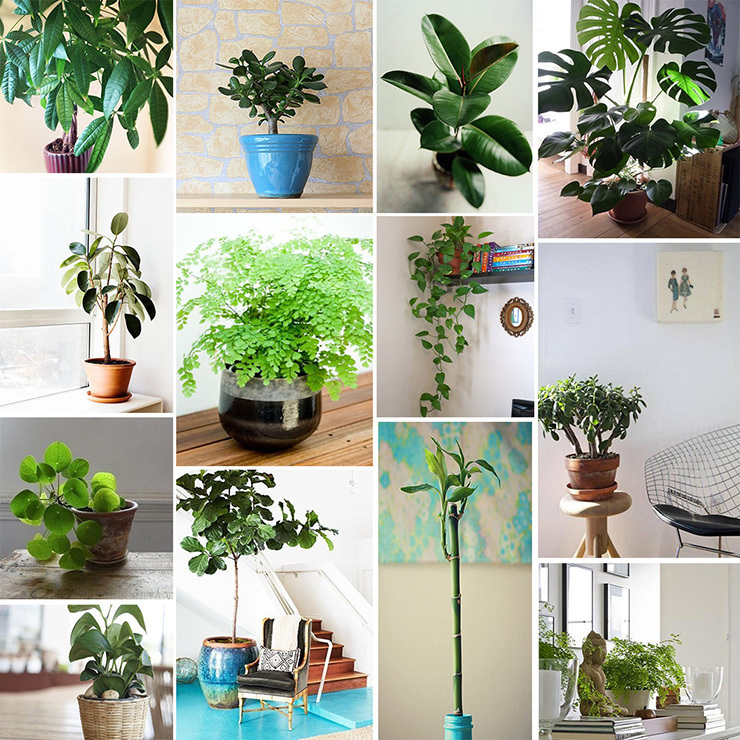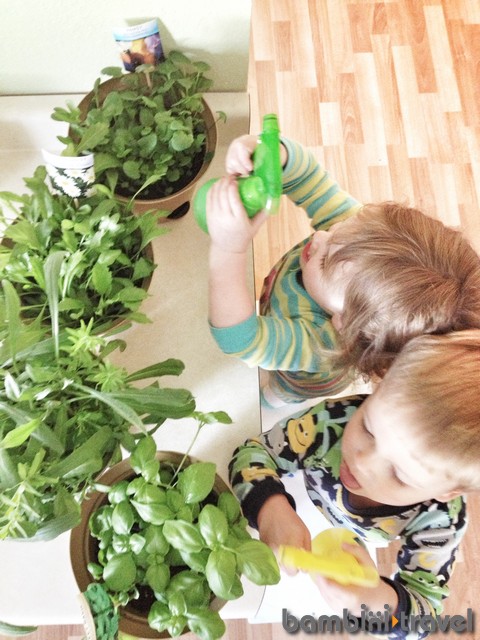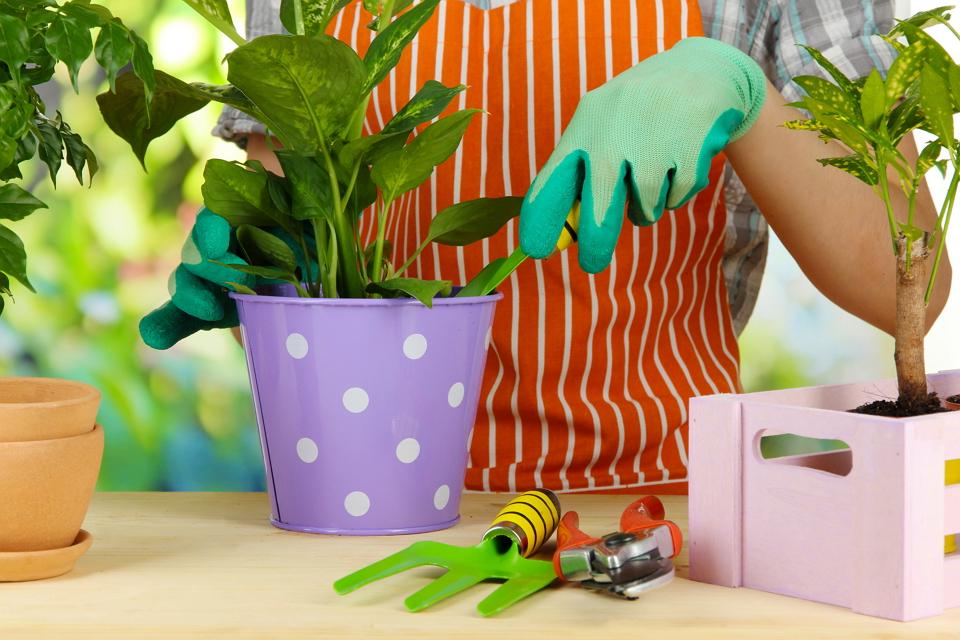Pros and cons of landscaping a nursery
In the room where the newborn will be for most of the day, the presence of any flowers is undesirable. If some flowers are acceptable, you must take care that they are not harmful to health. To do this, take the following measures:
- water indoor flowers regularly (the soil in pots should not be dry, as dust particles can spread from here);
- wipe dust on foliage with a damp cloth;
- place flower pots so that the baby cannot reach them;
- if you are very fond of cacti, give them up for a while or simply remove them from the nursery, as they can hurt the newborn;
- do not let the leaves of indoor plants dry out and fall off, as they collect a lot of bacteria.
Houseplants that are hazardous to health should be excluded, even if the newborn is completely healthy. Even if the child is not prone to allergic reactions, you still should not take risks and keep harmful flowers in the same room with the baby. See photos of plants that can be placed in the nursery.
It is important to note that in pots with indoor plants that will be installed in the room where the newborn is staying, there should only be clean soil. Better to buy it in a special store.
As a rule, the soil from the front garden is saturated with dangerous bacteria and microorganisms.
We recommend watching a video on the theme of gardening a children's room.
Criteria for the selection of plants for a nursery
Evaluating indoor crops in terms of benefits is not the most popular option. Perhaps the reason for everything is the generally accepted criteria for evaluating plants, in which toxicity is considered the most important of the negative "symptoms". But how plants purify the air or influence the atmosphere is often not mentioned at all.
Don't look for less harmful and less dangerous plants, just make a list of characteristics that are unacceptable for the nursery. And concentrate on something else - on what benefits houseplants can bring to the room in which your little one spends a lot of time.
All indoor plants produce oxygen to help create a healthy environment. But the "refreshing effect" is not the most important of the whole spectrum of positive effects of plants on our homes. The decisive criteria for the selection of useful plants for a nursery should be:
- color and harmonizing effect on the surrounding space;
- the ability to neutralize and absorb toxins and harmful substances (including those released by furniture and detergents);
- phytoncidal properties;
- noise-absorbing characteristics.
The correct selection of plants allows you to create a comfortable, healthy atmosphere with a minimum of their number. Indeed, in the children's room, even the classical number of pots with plants for the rest of the premises is inappropriate. Here it is permissible to expose only from 3 to 5 small and medium-sized plants or 1-2 large plants corresponding to them in terms of the "volume" of useful actions.
And they must always be in perfect condition: cleanliness, hygiene, timely cleaning of leaves and cleaning of plant debris are the only guarantees that the plants in the nursery will fulfill their "functions".
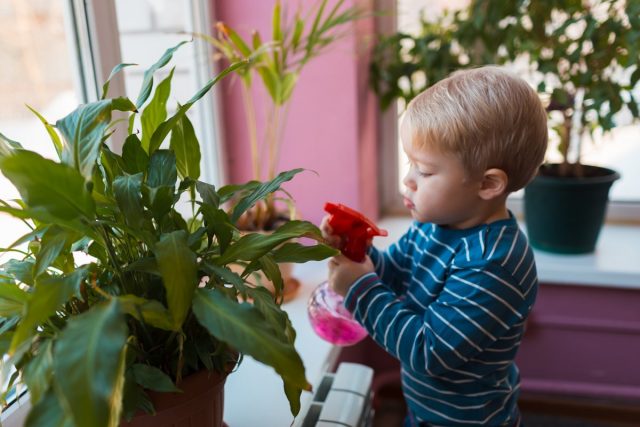 Indoor plants in the nursery will help children learn to care for them from an early age
Indoor plants in the nursery will help children learn to care for them from an early age
Useful flowers for home
There are several types of useful flowers for the home.
They are mainly used for medicinal purposes, as well as for the purification of oxygen, these include:
- Aloe. Among the people, he is often called an agave. This flower is just a storehouse of beneficial properties.It is difficult to name all the diseases and injuries in which it is used, but most often it saves from colds, intestinal disorders, pain in the stomach, and also promotes the rapid healing of wounds and cuts.
- Kalanchoe. The flower was brought to us from Germany. It perfectly cleans oxygen from pathogenic bacteria, so that it will be difficult to get a cold if there is such a defender in the house. Perfectly fights against rhinitis and sore throat.
- Spathiphyllum. An irreplaceable "vacuum cleaner" for cleaning indoor air. It actively fights against all harmful substances in the air and enriches the space with the necessary amount of oxygen. All the advantages of the plant include the fact that it blooms very violently and beautifully, and this improves the mood in winter.
- Geranium. There is no better remedy for depression than having this flower in your home. This natural antidepressant will improve sleep and normalize the nervous system.
When purchasing a plant, one should not forget about several poisonous representatives of the plant world, and these are dieffenbachia, oleander and azalea.
Boy's room
Boys prefer a different color palette than girls - a more contrasting one. Among the designs for children's rooms for boys, the most popular are the following colors: blue and all its shades, as well as the entire spectrum of green.
The nursery in green is suitable not only for boys, but also for girls. Choosing this color scheme, you can immediately solve several basic problems. As you know, green color calms and brings an element of harmony. For boys, this is only good, since they are very active by nature.
The color of the nursery can be blue, but it is preferable to choose its shade, for example, blue. It is suitable for less active children, its main feature is an increase in efficiency. It's great if you paint a student's room in this color.
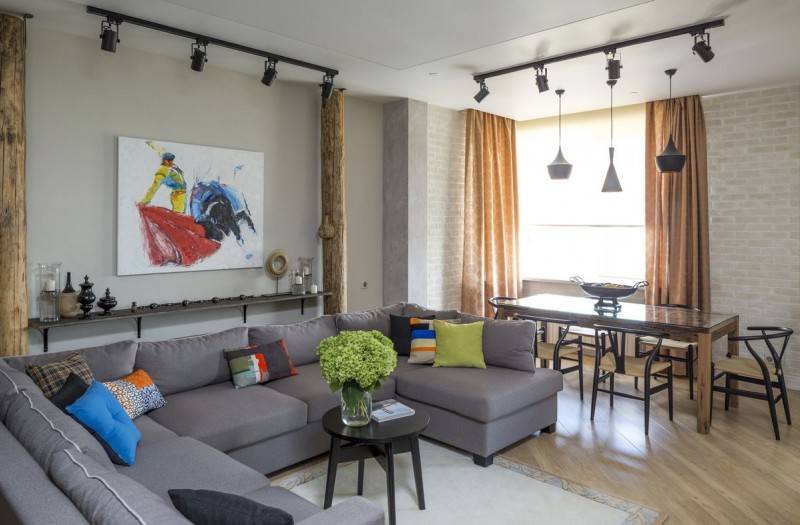

These two colors can be combined, therefore, choosing one of them, parents automatically use the second color in the additional arrangement. The area for recreation or games can be decorated with green, but the workplace should be in blue. In such a room, indoor plants are required - they will support the overall idea.
In the video: a design option for a room for boys.
No. 3. Growing or conventional furniture?
As you already understood, in the process of the child's growth, the set of furniture will have to be changed several times. But there is another option - furniture that grows with the child. Such sets are found mainly in the collections of European manufacturers. For example, the height of the table and the tilt of the table top can be adjusted, as can the height of the chair and the tilt of the back. The bed and some other pieces of furniture also vary in size.
It is functional, convenient, practical and will allow you to forget about buying new furniture for a long time, but, nevertheless, such sets are expensive and will be justified only if two or three sets of ordinary furniture are replaced.
The best useful plants for the nursery
What kind of flowers can you keep in the nursery? With the seeming simplicity of the question, the choice must be approached responsibly, because they must meet the basic safety requirements:
- lack of thorns;
- non-poisonous;
- neutral aroma;
- hypoallergenic.
These criteria are met by 10 indoor plants, which are increasingly chosen by caring mothers for their baby's room.
Chlorophytum
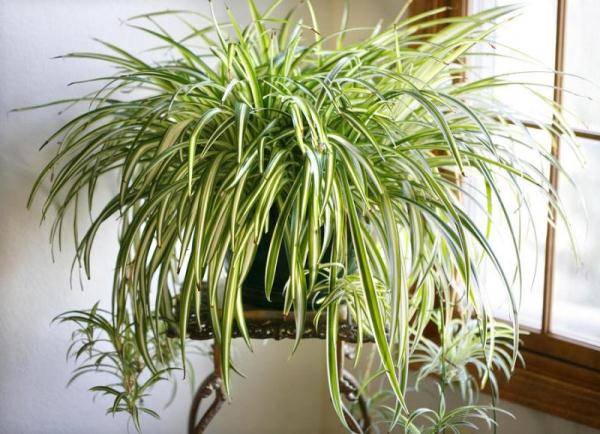
Cleans the air from harmful impurities and bacteria, does not require special care. Chlorophytum looks very attractive due to the numerous arrows with daughter rosettes at the ends. Even if the baby accidentally sucks chlorophytum leaves into his mouth, there will be no harm to him.
Sansevieria

An unpretentious plant that includes a large number of varieties. All varieties differ in color and pattern of leaves, as well as the height of an adult plant.Sansevieria blooms in indoor conditions rarely with small white flowers, but all its beauty lies precisely in the hard dense xiphoid leaves. Sansevieria purifies the air and grows rapidly with minimal maintenance.
Lemon Tree
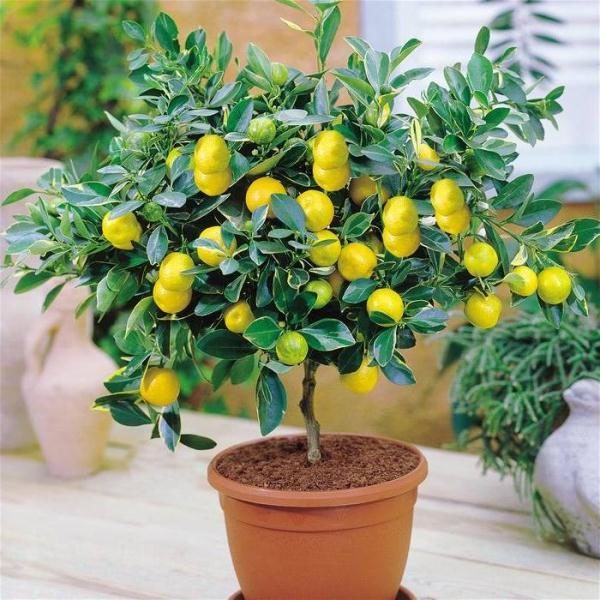
Releases essential oils into the air, killing harmful microbes and filling the air of the room with cleanliness and freshness. You can grow a lemon tree from a seed. It will be interesting for the kid to observe how an exotic tree with yellow fruits will eventually grow from a seed planted by him in the ground.
Hibiscus
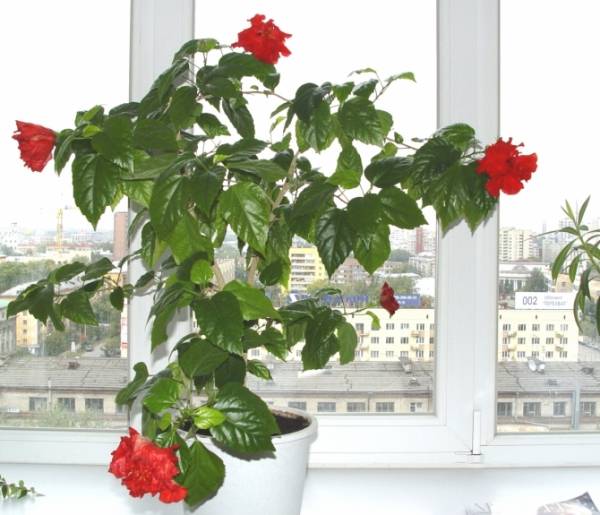
It is more expedient to put a young hibiscus in the children's room, since adult specimens can reach a height of 1.5-2 m and occupy a large space in the children's room. Hibiscus blooms with red, yellow or pink flowers and is easy to care for. Even in the absence of buds, the shiny foliage of the Chinese rose will decorate the interior.
Kalanchoe
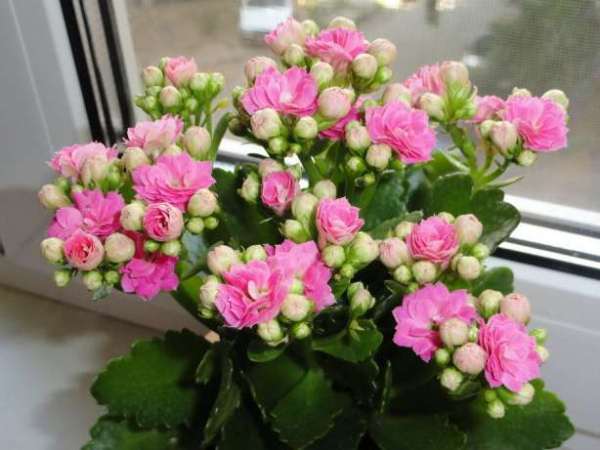
Any kind of Kalanchoe is suitable for a nursery: Blossfeld's Kalanchoe will delight you with bright flowers without an annoying smell, Kalanchoe Laciniata (dissected) will decorate the interior with carved fleshy leaves resembling deer antlers, and Kalanchoe Pinnate will help cure a runny nose.
Violets
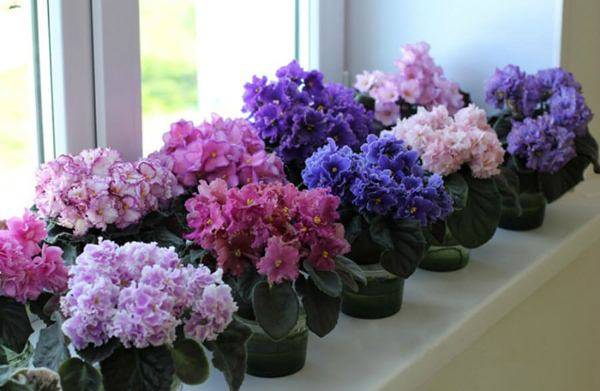
Usambara violets, or saintpaulias, are a great option for a nursery. Violets are non-poisonous - cats often like to gnaw on juicy thick leaves. A large number of varieties, shapes and colors of buds allows you to choose the best option. Violets are unpretentious to care for and do not require special conditions. Non-varietal varieties of Saintpaulias are often compared to weeds by flower growers - they are practically indestructible.
Begonia
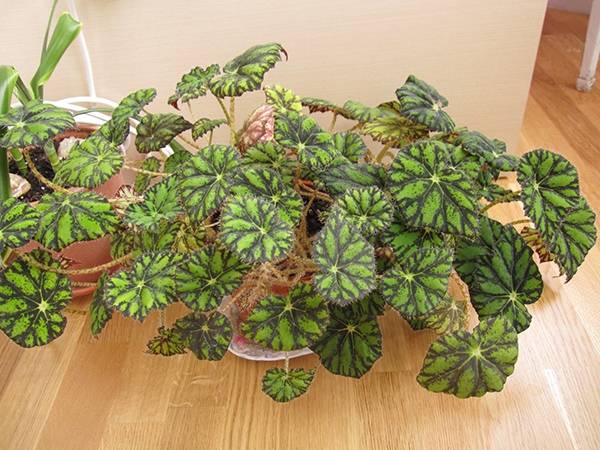
Perfectly cleans the air from dust and harmful bacteria. Releases essential oils into the air and has a beneficial effect on the baby's respiratory system. Begonia prefers a bright place and abundant watering. Many mothers are afraid of the edges on the leaves and stems of begonias. In fact, the hairs are not capable of injuring the child, as they are quite soft to the touch.
Cypress
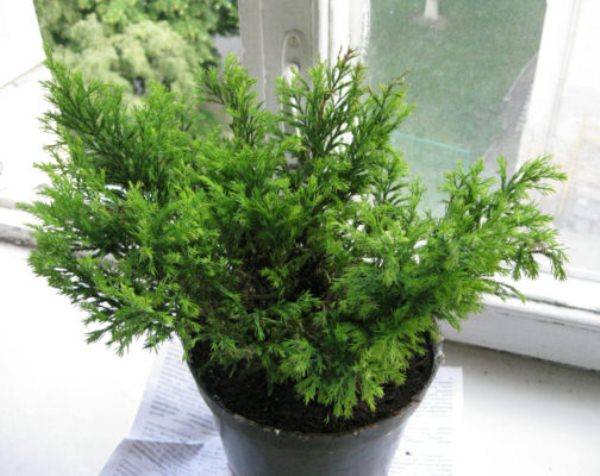
In appearance, the Cypress tree looks like a Christmas tree, only it does not prick and is not able to injure the baby. Releases phytoncides useful for the respiratory system into the environment, which simultaneously neutralize bacteria and fungi. Needs frequent spraying or a refreshing shower to wash away accumulated dust.
Spathiphyllum

Spathiphyllum purifies and humidifies the air. Differs in large dark green leaves and spectacular white flowers. It will not cause any particular difficulties in leaving and will create an atmosphere of happiness and love, because it is not for nothing that spathiphyllum is called the “flower of happiness”.
Decembrist
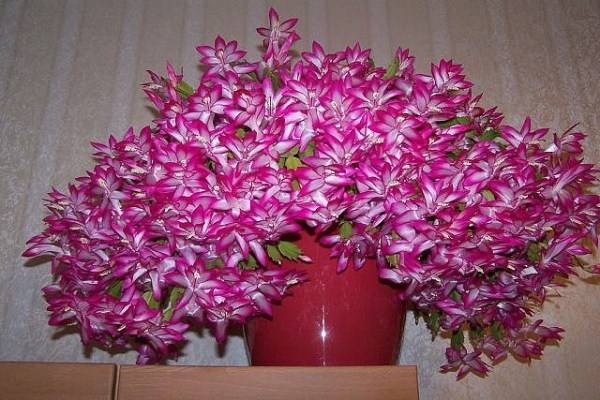
The word "Decembrist" is often referred to as Schlumberger and Ripsalidopsis. Both flowers are worthy to be in the nursery, as they are relatives and have similar characteristics. Caring for them is easy, but in winter, when most of the other plants are resting from flowering, the Decembrist opens up bright, spectacular buds. If you do not rearrange the pot, flowering can last 2-3 months.
When choosing indoor plants for a nursery, do not get carried away and do not force her to have a lot of flower pots. Limit 3-4 small ones or put 2-3 medium sized ones. Remember, plants absorb oxygen at night and release carbon dioxide into the surrounding air.
Additional tips and tricks
How to teach children to take care of plants and organize the space of the room:
- introduce the flower as a new friend and offer to give it a name;
- a pot can be made from a plastic bottle, a yogurt cup and decorated with your own hands;
- to save space, hang flowers at different heights, place them on cabinets and shelves, use whatnots;
- if you arrange a place for a home garden next to a desk, the light of a table lamp in the evening will additionally illuminate light-loving plants;
- trees and large shrubs will be easy to move during harvesting if placed on platforms with wheels.
With the help of indoor flowers in the nursery, you can create a corner of wildlife, put an aquarium, a cage with a hamster or a parrot next to it.
Share link:
Useful flowers
Not all plants can be placed in the nursery. It is undesirable to place too many pots here. The number of small and medium flowers should not exceed 5 pieces, instead of them you can put 2 large ones. To create a healthy, favorable atmosphere in a preschool educational institution, indoor plants are selected according to the following criteria:
- a pleasant shade that creates harmony in the surrounding space;
- the ability to absorb and neutralize toxic substances;
- release of phytoncides;
- the ability to absorb noise.
Plants need careful care. To make them useful, the leaves are wiped from dust in a timely manner, faded buds and wilted leaves are removed, fed and treated against pests. Then indoor flowers are beneficial for children.
Citrus trees

A lemon tree, miniature orange, or tangerine is best for a child's room. They secrete phytoncides, purifying the indoor air from pathogens. They are easy to grow on their own by planting an ordinary bone from the fetus. Kids are interested in watching a developing plant. Such trees usually do not bear fruit. But their thick, glossy foliage is pleasing to the eye. With good care, flowers appear on the trees.
Citrus trees need good lighting. Therefore, tubs with them are placed on the south side, closer to the windows. These plants require daily watering with moderate amounts of water. In winter, during the rest period, moisture is reduced. In summer, mineral fertilizers are periodically added to the irrigation water.
Chlorophytum

This plant has long, light green leaves arranged in small rosettes. Chlorophytums grow very quickly. During the active growing season, they release thin stems, on which small white flowers first appear. Then, instead of them, small rosettes of leaves are formed. They can be separated and used for reproduction.
Chlorophytum does not need careful maintenance. In kindergarten, these flowers are placed from the southeast or southwest side, creating diffused lighting. Plants are watered in moderation, regularly fed in the summer.
On a note!
According to feng shui experts, chlorophytums create a light, joyful atmosphere in the room.
Hibiscus
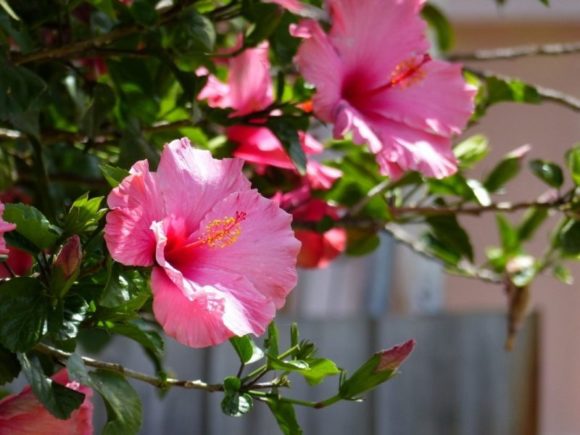
These flowers must be in the children's room. They are also called Chinese roses. Hibiscus is a small plant with woody stems covered with soft leaves with cut edges. During the flowering period from April to October, large buds of a red or yellow hue appear on it. The plant improves the composition of the air by releasing phytoncides. The scent of its flowers soothes the nervous system.
Hibiscus is easy to care for. They do not need frequent watering, they tolerate long-term lack of water. Plants are not afraid of drafts and sudden temperature changes. In kindergarten, these flowers can be kept on high stands. Hibiscus do not like frequent touching and feeling.
Balsam

Balsams are among the most beautiful and hardy representatives of indoor flora. During the flowering period, delicate buds of a red or pink hue bloom on them. The flower tolerates temperature changes well, withstands moisture deficit and excessive watering. Balsam is capable of self-recovery after improper care.
The flower is suitable to teach a child to care for indoor plants. According to flower growers, balsam has a soft, calm energy. It improves the child's creativity, reduces anxiety, makes him more collected and organized.
Myrtle
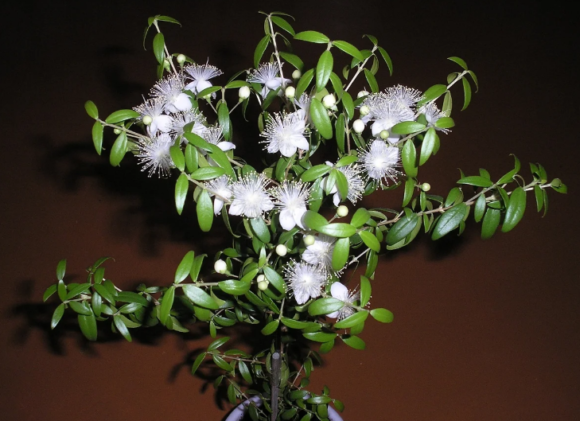
The compact evergreen bush is often grown at home. Its bright green leaves exude phytoncides, purify the air from harmful microorganisms and refresh it. Myrtle is regularly trimmed, giving the crown any shape.The flower is easy to grow on a windowsill, it can withstand temperature changes, drafts and direct sunlight. Water the plant often with plenty of warm, soft water.
Saintpaulia

The Uzambara violet is loved to grow by novice florists. She has large velvety leaves and small, bright flowers, collected in a rosette. Indoor Saintpaulia has a positive effect on the nervous system, improves immunity. Violet is not demanding to care for. She needs regular neat watering, occasional feeding and lighting with diffused light.
Correct flower placement
House flowers fill the air with oxygen only during the day. At night, the opposite process occurs: carbon dioxide is released from the leaves. Therefore, it is necessary to place flower pots in a child's bedroom wisely. Landscaping of the bedroom is performed taking into account its area and the age of the baby.
For newborn babies up to six months old, placing flowers in the room is not recommended. Representatives of indoor flora increase the load on the child's immunity. From six months, several flower pots can be transferred to the baby's bedroom. Choose plants that do not have a pungent odor. They are placed in the field of view of the child so that he can see the leaves, but he could not reach them and tear them off.
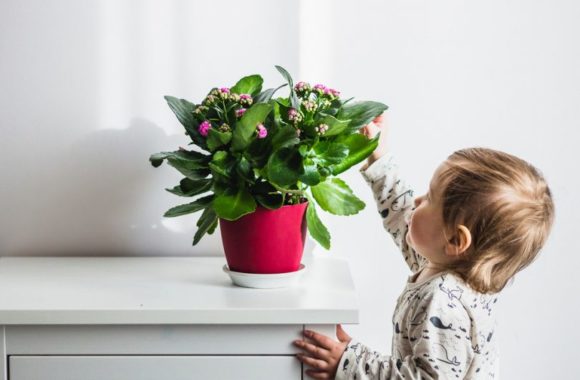
One-year-old children are already taking their first steps. At this age, babies are very curious. Flower pots are best placed in hanging pots to keep your baby safe. Containers can be placed on high racks or wall shelves.
At the age of 2 to 5 years, a period of increased activity begins. Everything becomes interesting to children. At this time, you can start teaching your child to care for houseplants. Therefore, it is better to transfer the pots to the windowsill. Caring for flowers prepares a child for adulthood and teaches a caring attitude towards nature.
Houseplants purify and heal the air in the room. Potted crops are beautiful and varied. They introduce the child to the world of beauty. Taking care of them, the baby gradually learns to work. For the children's bedroom, only useful flowers are chosen that purify the air and soothe the nervous system. They are placed so that the child cannot accidentally overturn the pot on himself.
Questions about the placement of flowers and houseplants in the nursery.
How many plants do you need for a nursery?
One or two plants will be enough for 15 m2, provided they are healthy.
What plants are dangerous for children?
You cannot place in the children's room:
Poisonous plants, for example:
- representatives of milkweed, as their juice can lead to skin irritation (Poinsettia, jatropha),
- ivy,
- other poisonous plants (adenium, dieffenbachia, oleander, codiaum, barringtonia)
- plants with poisonous fruits (euonymus, indoor nightshade)
Thorny plants and plants with sharp leaves.
Large indoor plants. For safety reasons, it is not recommended to place large plants in the child's room, as the child can turn over a heavy pot on himself and get injured.
Can ficus be placed in the children's room?
Sometimes ficus juice irritates the skin, so it is not recommended to put the ficus in an accessible place for babies. Ficus is safe outside the child's reach.
Pediatricians' opinions about harmless plants
Some indoor flowers (begonia, tradescantia, money tree) do not pose a potential danger to the newborn. However, doctors recommend placing them on the windowsill of the children's room closer to the time when the baby is one year old. It is known that some of these flowers emit carbon dioxide at night, which negatively affects the breathing of babies.
Any houseplant collects house dust on its leaves, which can cause an allergic reaction in a baby.
In the process of adapting a newborn to the environment, parents should do everything possible to ensure the safety of the baby.
Houseplants placement rules
Even useful plants in a child's room should be placed with care, observing some rules
- Firstly, they should not be located in places of active games and sleep of babies, should not interfere.
- Secondly, they should not prevent sunlight from entering the room.
- Third, do not overdo it with quantity.
- Fourth, consider the age of the baby.
How to calculate the number of plants by squaring a room
Too many indoor plants will drastically reduce the amount of oxygen in the nursery at night. And this will complicate the air circulation, because the flowerpots will emit volatile substances that will not have time to dissipate. Count on 1-2 flowerpots for every 4.5-5 m. One large plant will replace 3-4 smaller ones.
Landscaping of the nursery according to the age of your child
Conventionally, several age periods can be distinguished regarding the gardening of a children's room.
- 0-6 months. In order not to burden the baby's immune system, it is worth refraining from placing any plants in his room.
- 6-12 months. During this period, you can put the first flowerpot in the nursery. Choose a place for him so that the child can see and consider him, because at this age everything is a subject of study. Pick a plant without a strong scent.
- 1-2 years. The child can already move independently, actively studies the world around him and tries a lot "to the teeth", respectively, whatever flowers you decide to put in the nursery, they should be out of the reach of the crumbs. Hanging planters or tall shelves are suitable, for example.
- 2-5 years old. This is the age of "why". Indoor plants can serve as a visual aid for the development of flora. After all, it is much easier, answering questions, to give a living example than to explain in words. In addition, for the development of responsibility and hard work, the baby can already be entrusted with caring for his own flower.
6 best plants for a nursery
Based on the above criteria, chlorophytum, hibiscus, balsam, Saintpaulia, common myrtle and citrus plants can be called the best options for gardening a nursery.
Citrus trees
Lemon, orange and tangerine trees can be safely called the ideal choice for a child.
- firstly, they are natural phytoncides, therefore they kill all pathogens in the room.
- secondly, such plants can easily be grown on their own from an ordinary bone, which will be very interesting for the baby. In this case, they will hardly bear fruit, but they will delight the eye with thick, glossy green leaves, and with good care, and beautiful white flowers.
The only condition that citrus trees require is bright lighting, so it is better to place them closer to the windows. Watering is necessary daily, but moderate, and in winter it is reduced to a minimum, and top dressing is only in summer.
Chlorophytum
Chlorophytum crested is a plant with long light green leaves, collected in small rosettes. It grows extremely quickly, and in the spring and summer it releases thin shoots, on which first small white flowers appear, and then small rosettes of leaves.
It is very easy to care for chlorophytum - it needs diffused lighting, moderate watering and infrequent feeding.
In addition, this plant effectively cleans the air of toxic substances, and also, according to experts in feng shui, has a very light, joyful energy.
Hibiscus
Another really childish flowers are called hibiscus, or just a Chinese rose. Hibiscus is a compact, tree-like plant with soft, carved leaves and large, bright flowers in all shades of yellow and red (depending on the variety), which can be admired from April to October.
The plant not only significantly revitalizes the interior, but also has a beneficial effect on the composition of the air in the room and helps relieve tension and stress.
As for the ease of care, hibiscus has practically no equal here - it easily tolerates the lack of watering and temperature changes, but at the same time "does not like" too frequent touching and even more feeling.
Balsam
Balsam is one of the most beautiful and hardy houseplants that bloom with delicate pink or red flowers. The plant perfectly tolerates heat and coolness, is not afraid of drought or excessive watering, and can recover on its own even after serious mistakes in care.
Thanks to this, balsam is often chosen by parents who want to instill in their child a love for houseplants and the skills of caring for them.
As for the beneficial properties of this plant, many flower growers claim that it has a soft, calm energy, and will help the baby to become more organized and collected, as well as "wake up" his creativity.
Myrtle
Myrtle is a small ornamental shrub that belongs to the evergreen family.
The main feature of this plant is that its leaves are capable of releasing phytoncides, which disinfect and refresh the air in the room, and also actively fight against microbes and allergens.
In addition, the child will certainly be interested in the molding process, because the bright green crown of myrtle can be given almost any shape.
It is quite easy to grow myrtle on a windowsill - it is not afraid of temperature changes, drafts and sunlight. True, at the same time it requires quite frequent and abundant watering with settled water.
Saintpaulia
Saintpaulia, or uzambara violet, is a real favorite of novice florists, because this flower is great for learning how to grow, transplant and root plants.
It has pleasant to the touch, velvety leaves and very touching, delicate flowers, collected in small rosettes.
Many indoor plant lovers attribute to Saintpaulia not just healing, but truly magical properties - it is able to strengthen the immune system, bring harmony to the home atmosphere and smooth out conflicts.
As for care, this flower does not require anything special - just careful watering, soft lighting and occasional twisting.
Everything that surrounds the child in his room should not only be safe and practical, but also evoke positive emotions.
Before you put any house plant in the nursery, do not forget to ask the opinion of the little owner or hostess, because the baby must really fall in love with the new tenant - then they will be happy to share their care and good mood with each other.
Unsuitable flowers for the nursery
In addition to useful home flowers, there are other beautifully flowering flora that cannot be placed in a child's room. Some contain dangerous toxins that can cause poisoning. Others are covered with sharp thorns or have an intimidating appearance.
Flowers not suitable for growing in kindergarten with names and photos:
- nightshade forms poisonous berries after flowering;
- large-rooted alocasia - alkaloids and hydrocyanic acid are present in its leaves and other parts;
- sinadeum and dieffenbazia contain toxic substances in the juice;
- oleander is especially poisonous, even its aroma provokes loss of consciousness.
Many succulents and cacti are among the traumatic ones. They are covered with sharp thorns that can injure the baby. Also, do not place flowers with long foliage in the child's bedroom, for example, "mother-in-law's tongue" or sansevieria. Even when placed on high shelves, they hang low. The child can easily reach the leaves and overturn the pot on his head.
Important!
Sansevieria leaves have sharp edges. They will easily cut a child's fingers.
Children often fantasize, so you need to carefully choose the flora for them. It is undesirable to put plants with intricate outlines or predatory flowers in the children's room. They can be frightening. Sprawling palms and vines are not placed in the child's bedroom: monstera, scindapsus, dracaena, philodendron. On sunny days, their overgrown leaves cast intricate shadows in which a child can see a terrible monster.
Flowers of concern
Unfortunately, there are many bright indoor flowerpots that are not advisable to be placed in the room for children. Despite their attractiveness, they can have a detrimental effect on the well-being of the baby. Therefore, sensible parents choose only useful plants for the nursery in order to contribute to the successful development of the baby. Consider several options for indoor flowers that can lead to unexpected health problems in a child.
Orchid
This royal flower will not leave anyone indifferent. Its delicate buds of various tones can be looked at endlessly. Therefore, they are often bought to decorate home interiors. And how amazing the orchid looks in the children's room! A child can admire her beauty every day and develop a craving for beautiful things. But is this plant so harmless?
According to experts, the orchid can adversely affect the general condition of a person. This is reflected in the following factors:
- insomnia;
- dull headache;
- feeling tired;
- allergic reactions to a strong odor;
- sadness or depression.
Given these points, it is wise to think: is it worth putting these flowers in the nursery? Many parents have come to the conclusion that “God protects those who are saved,” therefore they place the orchid in the hallways, in the kitchen or in the winter garden on the balcony.
Ficus
Lovers of lush indoor greenery often grow large flowerpots:
- palm;
- dracaena;
- yucca;
- ficus;
- Chinese rose.
Each of them has its own characteristics, therefore, when caring for babies, you should consider all the pros and cons.
For example, having placed a ficus in the children's room, it is important to remember about its size and toxicity.
Of course, with the help of this luxurious plant, it is easy to create a unique design for a child's room. Wide fleshy leaves, located on a powerful trunk, arouse unprecedented admiration. The kid can even feel like the master of the jungle without leaving the house. But if he breaks at least one piece of paper, trouble can happen.
With any damage, the ficus secretes milk, which sometimes causes skin irritation. And if it gets into the eyes of a child? Perhaps, no one would like to check this information for themselves. Wise parents will think twice before placing a ficus in their child's room.
Cactus
These cute thorns are said to bloom once every 100 years. However, their gorgeous buds delight the eye much more often. In addition, the plant wonderfully purifies the air by absorbing harmful substances.
Despite these benefits, it is best to grow the cactus away from children. Since their curiosity has no limit, the thorns can come as a big surprise to them. It's good if it's just a light shot. Unfortunately, they can get deep into the skin and cause unbearable pain.

